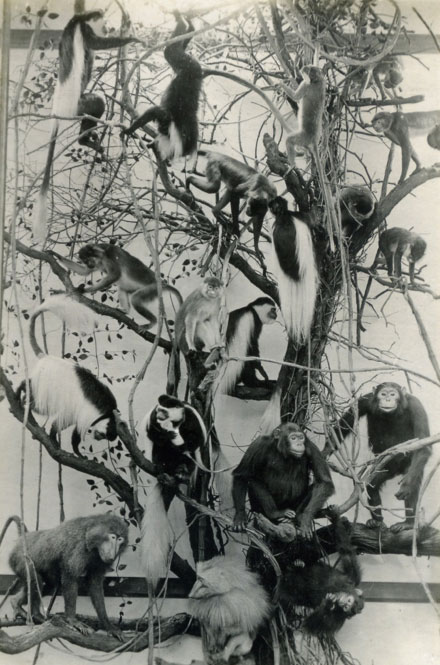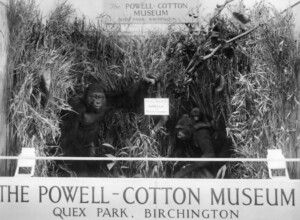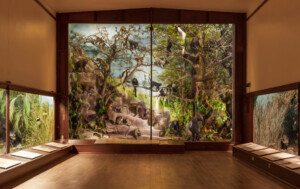Primate Diorama History
Our Curator of Natural History, Rachel, has been researching the Powell-Cotton Museum’s Primate Diorama. Here she gives a short account of its history:
The current Primate Diorama, displayed in Gallery 1, has its origins in an older display called the ‘Monkey Tree’. The Monkey Tree was created in 1921 by renowned taxidermy firm Rowland Ward Ltd., following detailed instructions by Percy Powell-Cotton. It was displayed in Gallery 3, in the case that currently displays textiles from Africa, from 1921 until 1939. The 1927 Museum guidebook lists 26 primates on display in the Monkey Tree. More taxidermy was commissioned in 1929, including eight monkeys, a group of five lowland gorillas, and two chimpanzees. These were displayed next to the Monkey Tree, in the same case.

The Monkey Tree, circa 1921
Construction on a new gallery (now Gallery 1) started in 1927, but was very slow due to Percy’s extensive travels – he was rarely home between 1928 and 1939 – and the economic downturn of the 1930s meant that money was tight. By 1936, work was underway on the Primate Diorama. This case included two trees, and an area of ‘rocks’ built from wooden crates covered with chicken wire and cement. The background was painted by a theatrical artist named Mr Wools.
In 1939, three of the lowland gorillas were displayed as a family group at the 18th annual Margate Exhibition and Civic Festival, held at the Winter Gardens 8th-18th February.

Gorilla family group at the 1939 Margate Exhibition
In March 1939, all of the primate specimens from Gallery 3 were moved into the new Gallery 1 diorama. There were 42 primates in the diorama at this point. Percy Powell-Cotton had intended to add more – a handwritten note dated 28 March 1938 lists “monkeys to be mounted for the new case” – but this work was not carried out before his death in 1940.
In 1948, his children Antoinette and Christopher chose additional specimens for the Primate Diorama, using Percy’s notes from 1938. A talapoin monkey, black colobus, and olive baboon were sent to Rowland Ward’s in 1949, and were all on display by 1952. The arrangement of the case has not been changed since, and the display continues to delight visitors today.

Gallery 1 Primate Diorama. Image © Nikhilesh Havel